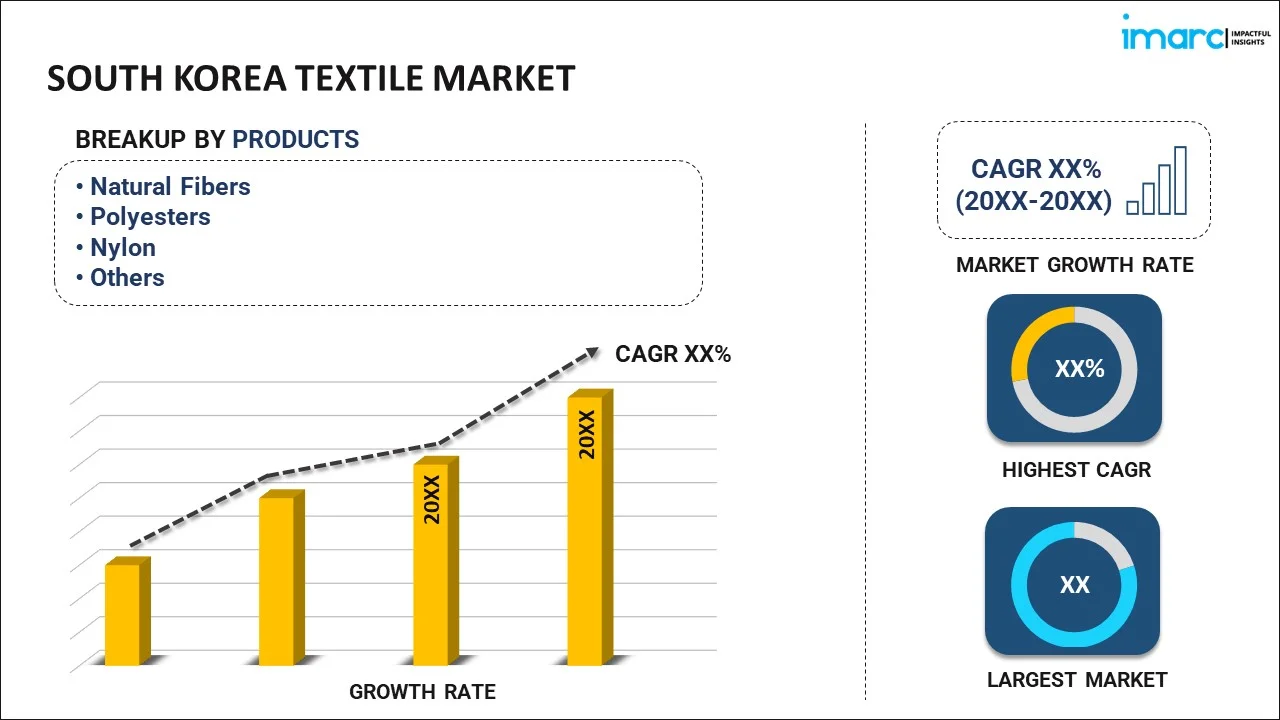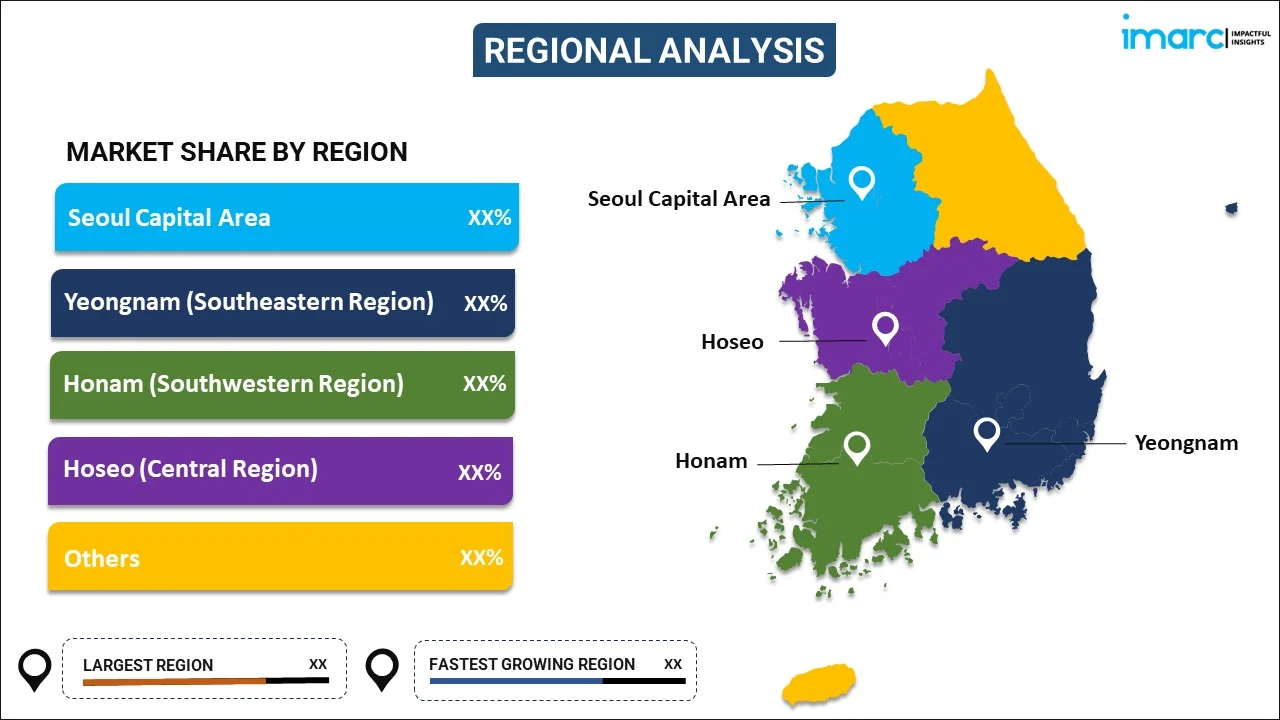
South Korea Textile Market Report by Product (Natural Fibers, Polyesters, Nylon, and Others), Raw Material (Cotton, Chemical, Wool, Silk, and Others), Application (Household, Technical, Fashion and Clothing, and Others), and Region 2025-2033
Market Overview:
South Korea textile market size reached USD 33.9 Billion in 2024. Looking forward, IMARC Group expects the market to reach USD 47.6 Billion by 2033, exhibiting a growth rate (CAGR) of 3.80% during 2025-2033. Ongoing technological innovation, sustainable practices, a flourishing fashion industry, government support, health-conscious consumer demands, e-commerce integration, a skilled workforce, and increasing adoption of Industry 4.0 represent some of the key factors driving the market.
|
Report Attribute
|
Key Statistics
|
|---|---|
|
Base Year
|
2024 |
|
Forecast Years
|
2025-2033 |
|
Historical Years
|
2019-2024
|
| Market Size in 2024 | USD 33.9 Billion |
| Market Forecast in 2033 | USD 47.6 Billion |
| Market Growth Rate (2025-2033) | 3.80% |
Textile refers to a versatile and ancient craft that involves the production of fabrics and materials through the interweaving of fibers or threads. The term encompasses a wide array of materials, including natural fibers like cotton, linen, wool, and silk, as well as synthetic fibers such as polyester and nylon. Textile production has evolved significantly with technological advancements, from manual looms to automated machinery. The process typically involves spinning fibers into yarn, followed by weaving, knitting, or felting to create the final fabric. Textiles serve functional purposes like clothing and shelter and contribute to cultural expression and artistic endeavors. Moreover, the global push towards sustainability and ethical practices is prompting a growing interest in eco-friendly alternatives and responsible production methods. Moreover, continuous technological advancements and innovations in smart textiles incorporating electronic components are further expanding the potential applications of textiles in the field of science and technology.
South Korea Textile Market Trends:
The country's strong emphasis on innovation and technological advancement, significant investments in research and development (R&D), particularly in the launch of high-performance and functional textiles is primarily driving the market growth. In confluence with this, the nation's strategic geographical location and well-established trade relationships fostering international trade are facilitating the export of textiles to various markets globally, creating a favorable outlook for market expansion. Moreover, the increasing awareness and growing demand for sustainable and eco-friendly practices spurring the adoption of environmentally conscious manufacturing processes and developing eco-friendly textiles is contributing to the market growth. In line with this, the burgeoning growth of the fashion industry, as the country continues to gain international recognition for its influential fashion trends is boosting domestic consumption and driving exports of South Korean textiles to meet the global demand for trendy and high-quality fabrics. Concurrently, government support and favorable policies, such as subsidies, tax incentives, and initiatives promoting the textile sector are providing an impetus to the market growth. Besides this, the government's focus on strengthening intellectual property rights has encouraged innovation within the textile industry, are fueling the market expansion. Additionally, the escalating health consciousness among consumers leading to an increased demand for textiles with functional properties such as antimicrobial and ultraviolet (UV) resistant features is acting as another significant growth-inducing factor. Furthermore, the rise of e-commerce platforms and digitalization facilitating easier access to a wide range of textile products through online retail channels is presenting lucrative opportunities for market expansion. Apart from this, the country's skilled workforce and the adoption of Industry 4.0 technologies, such as automation and data analytics, enhancing production efficiency and quality control in the textile manufacturing processes is propelling the market forward.
South Korea Textile Market Segmentation:
IMARC Group provides an analysis of the key trends in each segment of the market, along with forecasts at the country level for 2025-2033. Our report has categorized the market based on product, raw material, and application.
Product Insights:

- Natural Fibers
- Polyesters
- Nylon
- Others
The report has provided a detailed breakup and analysis of the market based on the product. This includes natural fibers, polyesters, nylon, and others.
Raw Material Insights:
- Cotton
- Chemical
- Wool
- Silk
- Others
A detailed breakup and analysis of the market based on the raw material have also been provided in the report. This includes cotton, chemical, wool, silk, and others.
Application Insights:
- Household
- Technical
- Fashion and Clothing
- Others
The report has provided a detailed breakup and analysis of the market based on the application. This includes household, technical, fashion and clothing, and others.
Regional Insights:

- Seoul Capital Area
- Yeongnam (Southeastern Region)
- Honam (Southwestern Region)
- Hoseo (Central Region)
- Others
The report has also provided a comprehensive analysis of all the major regional markets, which include Seoul Capital Area, Yeongnam (Southeastern Region), Honam (Southwestern Region), Hoseo (Central Region), and Others.
Competitive Landscape:
The market research report has also provided a comprehensive analysis of the competitive landscape in the market. Competitive analysis such as market structure, key player positioning, top winning strategies, competitive dashboard, and company evaluation quadrant has been covered in the report. Also, detailed profiles of all major companies have been provided.
South Korea Textile Market Report Coverage:
| Report Features | Details |
|---|---|
| Base Year of the Analysis | 2024 |
| Historical Period | 2019-2024 |
| Forecast Period | 2025-2033 |
| Units | Billion USD |
| Scope of the Report | Exploration of Historical Trends and Market Outlook, Industry Catalysts and Challenges, Segment-Wise Historical and Future Market Assessment:
|
| Products Covered | Natural Fibers, Polyesters, Nylon, Others |
| Raw Materials Covered | Cotton, Chemical, Wool, Silk, Others |
| Applications Covered | Household, Technical, Fashion and Clothing, Others |
| Regions Covered | Seoul Capital Area, Yeongnam (Southeastern Region), Honam (Southwestern Region), Hoseo (Central Region), Others |
| Customization Scope | 10% Free Customization |
| Post-Sale Analyst Support | 10-12 Weeks |
| Delivery Format | PDF and Excel through Email (We can also provide the editable version of the report in PPT/Word format on special request) |
Key Questions Answered in This Report:
- How has the South Korea textile market performed so far and how will it perform in the coming years?
- What has been the impact of COVID-19 on the South Korea textile market?
- What is the breakup of the South Korea textile market on the basis of product?
- What is the breakup of the South Korea textile market on the basis of raw material?
- What is the breakup of the South Korea textile market on the basis of application?
- What are the various stages in the value chain of the South Korea textile market?
- What are the key driving factors and challenges in the South Korea textile?
- What is the structure of the South Korea textile market and who are the key players?
- What is the degree of competition in the South Korea textile market?
Key Benefits for Stakeholders:
- IMARC’s industry report offers a comprehensive quantitative analysis of various market segments, historical and current market trends, market forecasts, and dynamics of the South Korea textile market from 2019-2033.
- The research report provides the latest information on the market drivers, challenges, and opportunities in the South Korea textile market.
- Porter's five forces analysis assist stakeholders in assessing the impact of new entrants, competitive rivalry, supplier power, buyer power, and the threat of substitution. It helps stakeholders to analyze the level of competition within the South Korea textile industry and its attractiveness.
- Competitive landscape allows stakeholders to understand their competitive environment and provides an insight into the current positions of key players in the market.
Need more help?
- Speak to our experienced analysts for insights on the current market scenarios.
- Include additional segments and countries to customize the report as per your requirement.
- Gain an unparalleled competitive advantage in your domain by understanding how to utilize the report and positively impacting your operations and revenue.
- For further assistance, please connect with our analysts.
 Inquire Before Buying
Inquire Before Buying
 Speak to an Analyst
Speak to an Analyst
 Request Brochure
Request Brochure
 Request Customization
Request Customization




.webp)




.webp)












